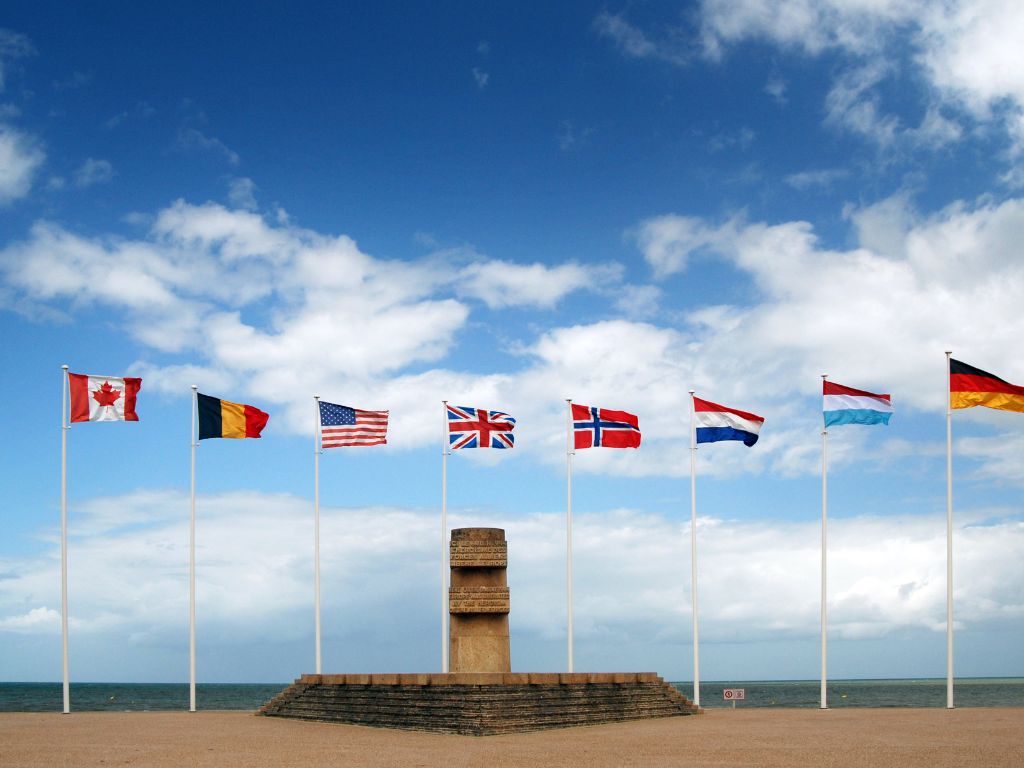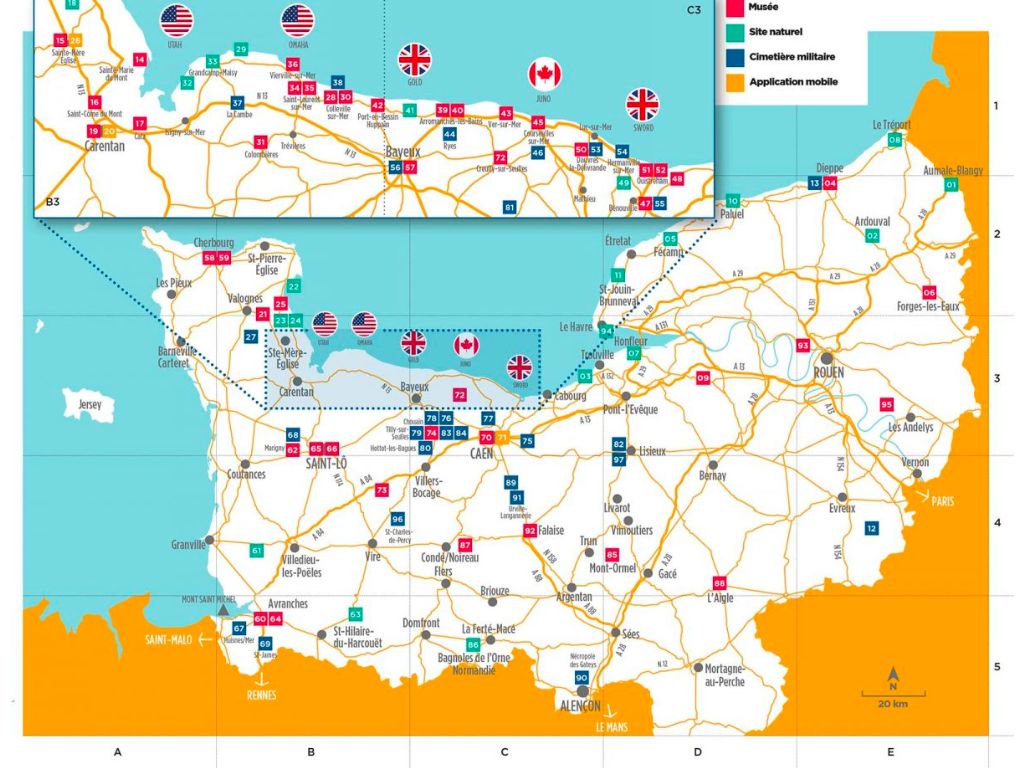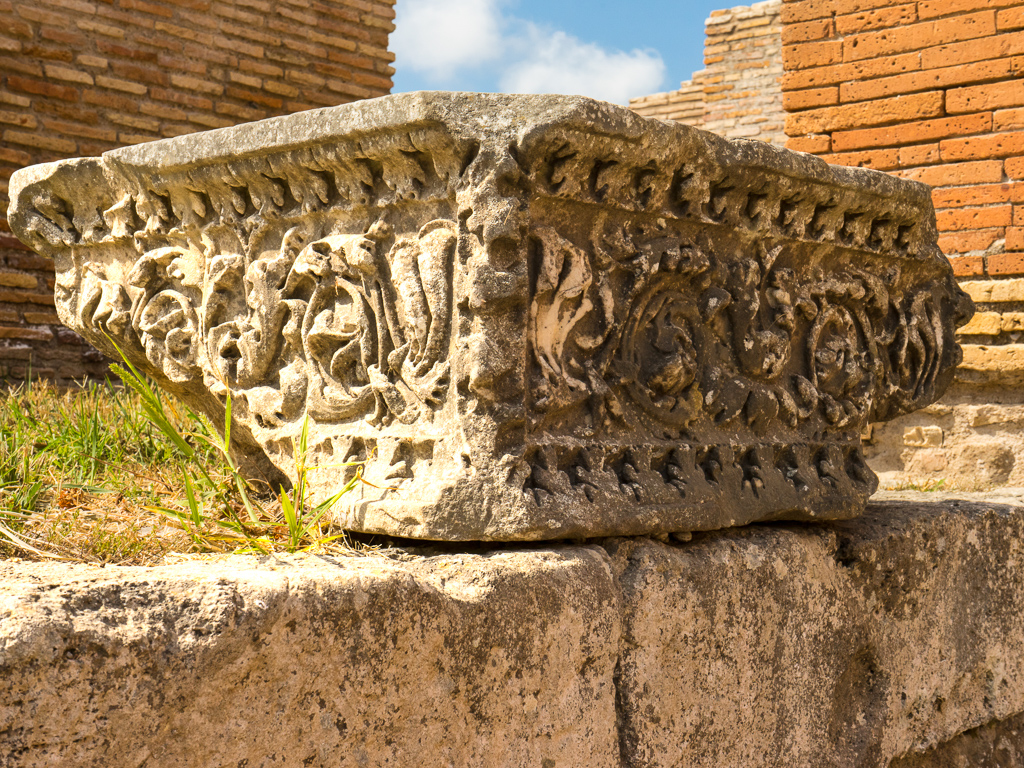Visiting the D-Day Beaches: With Normandy Beach Map

Learn more about the historic Normandy Beaches during Context's Full-Day Private Tour with Private Car Service
Over one million people visit the beaches of Normandy every year to pay respects to the soldiers who lost their lives and experience the site of one of World War II’s most crucial turning points.
When was the D-Day Invasion?
D-Day, also known as Operation Overlord, was a significant event in history that took place on June 6, 1944. It marked the beginning of the Allied invasion of Normandy during World War II – which continued until July 24, 1944.
On this day, a massive amphibious assault was launched on the beaches of Normandy, France, by British, American, Canadian, and other Allied forces. D-Day represented a pivotal moment in the war, as it opened a crucial front against Nazi Germany and ultimately led to the liberation of Western Europe from the control of the Axis powers.
If you’re interested in touring this historic site, here’s what you need to know about planning a visit to the D-Day beaches in Normandy.
Can you visit D-Day Beaches?
Visitors can walk the beaches, but those inclined to learn more about history can visit dozens of nearby museums and monuments. Planning ahead will help you optimize your itinerary and ensure you get the most out of this impactful experience.
Context offers a Full-Day D-Day and Normandy Beaches Tour so you can explore key Normandy landmarks, including Normandy Landing Beaches, Pointe du Hoc, Omaha Beach, The Normandy American Cemetery and Memorial, and the Mulberry Harbour at Arromaches.
An expert on D-Day history leads the full-day tour, and it is a meaningful and educational opportunity to learn more about the events of June 6, 1944 and their impact on European liberation.

What were the 5 beaches on D-Day?
Code-named Operation Overlord, the Allied Operation included over 156,000 American, British, and Canadian troops landing on five beaches along a 50-mile stretch of coastline occupied by Germans. This meticulously planned amphibious military assault is widely considered the turning point in World War II and ultimately led to the liberation of France and the rest of Western Europe.
1. Utah Beach
Utah Beach was a last-minute addition to the plan due to its proximity to Cherbourg, a port city. Sadly, many U.S. paratroopers perished when their heavy equipment weighed them down in the flooded marshlands near the beach. Others landed outside their drop zones, but they eventually secured the beach’s only four exit points.
2. Omaha Beach
Because U.S. troops suffered massive casualties at Omaha beach, it is named the bloodiest beach on D-Day. About 2,400 U.S. troops were dead, wounded, or missing once the battle ended. Omaha beach was flanked by steep cliffs and was heavily defended, making it a perilous and devastating battle scene.
3. Gold Beach
British troops stormed Gold Beach, located in the middle of the five D-Day Beaches, about an hour after Utah and Omaha (due to the direction of the tides). While the Germans initially had a stronghold on the beach, British warships, aerial attacks, and armored vehicles proved victorious.
4. Sword Beach
Canadian and British troops invaded Sword Beach’s eastern flank and took out key bridges to prevent German reinforcements from arriving. The Germans answered with moderate fire, but the British and Canadian troops took out critical German artillery resources.
5. Juno Beach
Rough seas made for a challenging landing at Juno Beach, giving German soldiers the initial upper hand. Canadian troops faced monumental casualties as Germans fired from seaside bunkers. However, as soon as German resistance slowed, Canadians quickly advanced inland and captured several towns.

World War II Sites to Visit in Normandy
Did you know that D-Day was only the beginning of the Allied Invasion of Normandy? For twelve more weeks after June 6th, Allied forces continued to fight. Normandy played a large role in World War II, so it's no surprise that history buffs flock to the area to see the many significant locations across this region firsthand.
Omaha Beach
The serenity of Omaha Beach today starkly contrasts the violent scene that occurred here nearly 80 years ago. Visitors walk the coastline and honor those who lost their lives in a wartime battle that lives in infamy.
Visitors can also see remnants of the artificial harbor constructed by the Allies, known as Mulberry Harbour, and view the German bunkers and fortifications that remain on the beach. There are also several museums in the area, including the Omaha Beach Memorial Museum.
Normandy American Cemetery
Just beyond Omaha, the Normandy American Cemetery honors the American troops who gave their lives on the D-Day beaches. It is a poignant way to pay tribute to the legacy of those U.S. troops who never had the opportunity to return home.
Each of the 9,386 headstones contains the name, date of death, service unit, and country where he volunteered, except for the 307 who have no name. There is also a monument to the 1,557 servicemembers whose mortal remains were lost.
Caen Memorial Museum
As you make your way across the D-Day sites, plan a visit to the Caen Memorial Museum. The Museum focuses on the Battle of Normandy and 20th-century history, offering visitors unique insights into the events that marked World War II.
With a range of exhibits that provide a glimpse into the wartime life of troops and civilians, the Museum offers multimedia experiences, films, and a firsthand look at personal items from soldiers.
Arromanches-les-Bains
Today, this picturesque town is known as a seaside resort, but its coast, Gold Beach, played a major role in the Normandy landings.
Gold Beach was one of the beaches designated to receive man-made landing harbors on D-Day, also known as Mulberry Harbours. The harbors were specially created to float across the English Channel and serve as temporary harbors on D-Day. Many of the large concrete blocks remain in Arromanches today as a reminder of its significance to World War II.
Longues-sur-Mer
Longues-sur-Mer was a battery built by the German navy and strategically positioned between the Omaha and Gold Beaches. On D-Day, Longues-sur-Mer was the site of an extended gunfight between the Allied fleet and the Germans. British troops eventually landed at Gold Beach and captured both the position and the surviving German soldiers.
Visitors today can see the original cannon and take in the view from the firing command. Longues-sur-Mer is one of the best-preserved World War II sites anywhere in France, giving visitors an unparalleled view not just of the Bay of Seine, but of what life was like on that fateful day in 1944.
Map of D-Day Beaches

Each beach has its own unique history, and as you examine the map you’ll gain a deeper understanding of the scale and scope of this historic operation.
To look at a Normandy Beach map is not just a lesson in geography; it’s a lesson in understanding what happened on June 6, 1944. Looking at the map, you can imagine the struggles, triumphs, and heart-wrenching losses suffered on the sand.
Whether you’re zooming in for a closer look at each beach’s remaining craters, or as you stand in person on the hillside above a neverending sea of white headstones, you’ll come away with a sense of gratitude, awe, and respect for those who gave their lives on the beaches of Normandy.
Tips and Tricks for Visiting the Normandy Beaches:
- Hire a Context Tour Guide, with Private Car Service: A knowledgeable local historian can offer unique insights into each landmark’s significance to WWII and provide you with a more personalized experience. Additionally, while it is possible to visit the beaches using public transportation, it's much more convenient to rent a car and book a tour. This will give you more flexibility to explore the area at your own pace.
- Dress appropriately: Wear comfortable clothes and shoes for walking, and bring a jacket in case it gets cold or rainy. Because you will be along the coastline, wind gusts can be an important factor when planning your wardrobe.
- Pack snacks and water bottles: Weather conditions can be brutal, especially during the summer. While most museums do offer concessions, it’s important to be prepared with adequate water and snacks to keep yourself comfortable throughout the day.
- Consider visiting early or late in the day: To avoid crowds, it's best to visit the beaches early in the morning or later in the afternoon.
- Allow plenty of time: Plan to spend a full day or more exploring the Normandy beaches. There is a lot to see and learn, and rushing through the sites won't do them justice. You’ll also want to consider the seasonal tides so that you can safely walk along the beaches.
- Respect the sites: The D-Day beaches and surrounding areas are sacred places. Show respect by not littering, staying on designated paths, and not disturbing any artifacts.
- Take a moment for reflection: The D-Day beaches are solemn places that hold somber historical significance. Take a moment to reflect on the sacrifices made by the thousands of brave souls who fought and died there.

Tour the D-Day Beaches
Enhance your Normandy experience with a guided tour of the D-Day Beaches with a local expert. Our Full-Day D-Day and Normandy Beaches Tour has exclusive insights into World War II history to ensure you leave Normandy with a complete understanding and appreciation for its pivotal role in the war.
If you’re looking for other opportunities to learn more about Normandy, take our Full-Day Mont-Saint-Michel Tour and see this gravity-defying medieval monastery with an expert guide.
Learn more about the Normandy Beaches with Context Learning
Are you planning a trip to France? Check out Context’s Upcoming Online Seminars and Courses about France – which feature local experts in WWII History, Archaeology, and Art History.
Or, stream French History and Culture content instantly through Context On-Demand – hosted by the same local experts who lead our tours.
You May Also Like:
Even More from Context
We're Context Travel 👋 a tour operator since 2003 and certified Bcorp. We provide authentic and unscripted private walking tours and audio guides with local experts in 60+ cities worldwide.
Search by CityKeep Exploring











